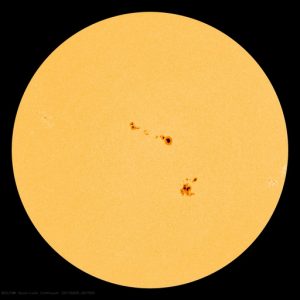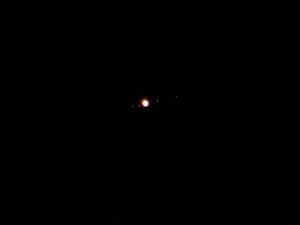Although, yes, you should just keep them until the eclipse in the US in 2024 (or the one in the Andes in 2019, which I haven’t completely ruled out just yet, because I’ve become a crazy person), there’s another good reason to keep a pair or two handy:
Sunspots!
More specifically: GIANT sunspots!
Right now, there are two fairly-large sunspot areas on the face of the sun. They’re so big, in fact, that they can be seen without magnification. Just put on your eclipse glasses and take a gander. Both of them are pretty close to the center of the solar disk, as seen by the picture above (which is from late yesterday). These will continue to rotate left-to-right across the face of the sun over the next several days.
Take a look; this is pretty cool (bonus points if you work in an office and go out and stand in the parking lot looking up at the sun for no apparent reason).
Space Weather
My favorite site to keep up on this sort of thing is spaceweather.com. Our “space weather” is almost-entirely affected by the sun, so most things on the site lean that way. If civilization as we know it is about to be ended by another Carrington Event, this will be one of the early places to hear about it.
Eclipse Glasses
Quick note about eclipse glasses. Although I heard a few mixed reports about whether or not eclipse glasses would degrade over time and therefore only be safe to use for the next few years, this appears to not be the case:
Such warnings are outdated and do not apply to eclipse viewers compliant with the ISO 12312-2 standard adopted in 2015.
So, keep track of those things, as long as you’ve got good ones.










